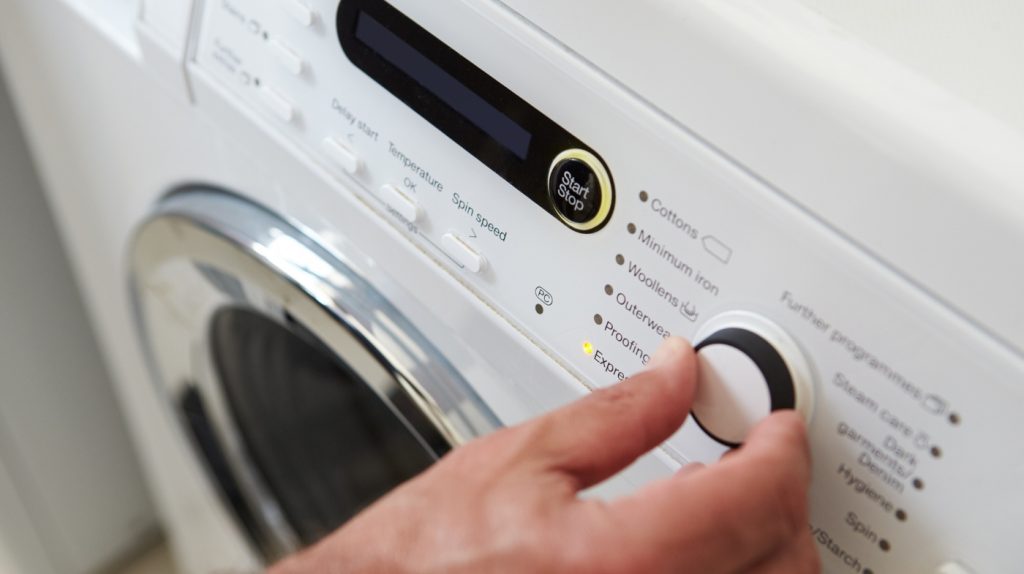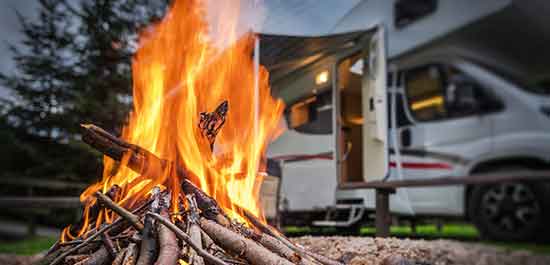Last Updated on April 30, 2025
To winterize your RV washing machine, first drain all water from hoses, pumps, and internal parts to prevent freezing. Disconnect hoses and use compressed air to clear trapped moisture.
Pour ½ to 1 quart of RV-safe antifreeze directly into the drum, then run a cycle to circulate it through the system. Follow with a drain/spin cycle to remove excess antifreeze.
Finish by inspecting components for damage. You’ll find detailed steps and maintenance tips to guarantee your washer stays protected all winter.
Key Takeaways
- Drain all residual water from hoses, pumps, and internal washer components to prevent freezing damage.
- Use compressed air to expel trapped moisture from inlet hoses before storage.
- Pour ½ to 1 quart of RV-specific antifreeze into the drum and run wash cycles to circulate it internally.
- Run a Drain/Spin cycle to remove excess antifreeze and ensure internal parts are coated and protected.
- Inspect hoses for cracks, flush antifreeze residue, sanitize, and verify no leaks before storing the washer.
Preparing Your RV Washing Machine for Winter
Before the cold sets in, you’ll want to thoroughly prepare your RV washing machine to prevent damage from freezing temperatures.
Start by draining all residual water from hoses, pumps, and internal components use compressed air to expel trapped moisture, especially from inlet hoses. Detach and inspect hoses for wear or mineral buildup, then store them dry. It is also important to connect a short hose to the washer connections for a mess-free winterization process.
Next, apply nontoxic RV-specific antifreeze by running a wash cycle until the antifreeze reaches the drum and drain lines, confirming flow by observing pink liquid. Avoid household antifreeze to protect seals.
Clean lint and debris from filters and pumps, sanitize the drum and seals with RV-safe cleaners, and dry detergent dispensers and trays to prevent clumping. Leave the door ajar and place moisture absorbers near seals to inhibit mold growth.
Step-by-Step Winterizing Process
With your RV washing machine properly prepared to handle freezing temperatures, you can move on to the detailed winterizing procedure.
First, disconnect the hot and cold water hoses and drain any residual water to prevent freezing. Unplug the washer to eliminate accidental starts. Let the disconnected hoses drain into a towel to ensure no water remains in the lines for thorough draining.
Next, pour ½ to 1 quart of RV-specific antifreeze into the drum, ensuring it’s compatible with your model. Rotate the program selector to a suitable cycle, like Cotton Heavy Duty, to circulate antifreeze through internal components. Monitor the Status/Door Lock LED for cycle progress.
After the cycle, run a Drain/Spin cycle to expel excess antifreeze, then verify all fluid is removed. Finally, disconnect power and double-check that hoses are drained and disconnected. Inspect the system for leaks to complete the winterizing process.
Running the Winterizing Cycle Effectively
To run the winterizing cycle effectively, start by ensuring your RV washing machine is powered off and set the program selector to REGULAR with the wash temperature on HOT. It is important to use RV-type antifreeze to protect the washer-dryer components from freezing damage.
Next, add ½ to 1 quart of RV antifreeze directly into the drum or allow it to enter via inlet hoses during the fill phase if using a pumped system. Press the ON/OFF button to initiate filling.
Once antifreeze visibly coats the drum, rotate the selector to RESET and wait five seconds for the LED to blink, then advance to SPIN to drain. Repeat the entire cycle with wash temperature set to COLD to protect cold water lines.
Finish by spinning to expel antifreeze from pump and hoses, ensuring all components are coated and lubricated before powering off and unplugging.
Essential Maintenance After Winterizing
After completing the winterizing cycle, you’ll want to shift focus to maintaining your RV washing machine to make certain it stays in peak condition.
Start by inspecting hoses for cracks or brittleness and flush them to clear antifreeze. Sanitize the washer with a detergent cycle, wipe seals, and clean lint filters.
Check electrical components, test the motor, and lubricate moving parts per manufacturer guidelines. Run rinse cycles to remove antifreeze residue and verify no pink discharge remains.
It is important to run a warm cycle during winterizing to ensure antifreeze flows through both hot and cold valves antifreeze flow. Reconnect hoses carefully, check for leaks, and confirm water pressure and temperature settings.
| Task | Action | Purpose |
|---|---|---|
| Hose Inspection | Check for damage and flush with water | Prevent leaks and residue build-up |
| Electrical Check | Test cords, controls, motor, and locks | Make certain safe, responsive operation |
| Cleaning & Sanitizing | Run detergent/bleach cycle and wipe down | Remove antifreeze, prevent odors |
Getting Ready for De-Winterization
Before you begin de-winterizing your RV, thoroughly inspect all exterior surfaces and plumbing systems to identify any damage or weaknesses that could worsen during reactivation.
Check the roof for cracks or compromised sealant, and verify water pipes are intact without leaks. Lubricate hinges, stabilizers, and metal components to prevent corrosion.
Ascertain all fresh water and low-point drains are securely closed before connecting to a potable water source. Run a cleaning cycle on the washing machine with warm water and bleach to eliminate residue, inspecting seals and hoses for deterioration. It is also important to check low point drains to ensure all antifreeze is properly flushed out.
Confirm no leaks exist in faucets or taps, and test electrical systems and appliances for proper function. Completing this detailed inspection and preparation ascertains a smooth, damage-free de-winterization process and extends your RV’s operational lifespan.
Frequently Asked Questions
Can I Use Automotive Antifreeze Instead of RV Antifreeze?
You shouldn’t use automotive antifreeze instead of RV antifreeze because automotive antifreeze contains toxic ethylene glycol, which can contaminate your washing machine’s water lines and pose serious health risks.
It can also damage rubber seals and hoses and is difficult to flush out completely. RV antifreeze, made from non-toxic propylene glycol, is specifically formulated to protect water systems safely.
How Often Should I Winterize My RV Washing Machine?
You might think winterizing once is enough, but you should winterize your RV washing machine annually before freezing temps hit to avoid ice damage. If your RV faces multiple freeze-thaw cycles, increase the frequency. Even in mild winters, check yearly.
When storing the RV unused for months, winterize immediately. Frequent winterization protects internal components, prevents costly repairs, and guarantees your machine runs smoothly season after season.
Is It Safe to Leave the Washing Machine Door Closed During Winter?
Yes, it’s generally safe to leave your washing machine door closed during winter storage, especially after properly winterizing it. Closing the door helps prevent dust and debris from entering the drum and seals the interior from external contaminants.
However, make sure you’ve fully drained the water and circulated RV-specific antifreeze through the system to avoid freezing damage. Always inspect seals and connections afterward to confirm no leaks or residual moisture remain inside.
Can Winterizing Damage the Washing Machine’S Electronic Components?
Sure, winterizing your washing machine won’t magically turn it into a snowman, but if you’re careless, you might just ice its electronics instead. Using the wrong antifreeze or skipping thorough draining can cause corrosion, sensor damage, or short circuits.
So, always follow manufacturer guidelines, use RV-specific antifreeze, and power down properly. Otherwise, you risk costly repairs that no amount of winter prep can fix.
What Should I Do if Antifreeze Leaks Inside the Machine?
If antifreeze leaks inside your machine, first disconnect power immediately to avoid electrical hazards. Inspect all seals, hoses, and connections carefully for damage or wear, replacing any compromised parts.
Thoroughly flush the system with fresh water to remove residual antifreeze and prevent corrosion or mold growth. Test the pump and drainage to confirm proper circulation.
Finally, allow the interior to dry completely before reassembling or restarting the machine.
Winter-Ready and Worry-Free: Your RV Washer Survival Guide
Winterizing your RV washing machine guarantees it’s primed to face cold months without damage. Follow each step meticulously to avoid costly repairs remember, an ounce of prevention is worth a pound of cure.
After flushing out water and adding antifreeze, perform essential maintenance to keep parts in top shape. When spring arrives, prepare for de-winterization with the same care.
Staying detailed and precise now saves you headaches down the road.



